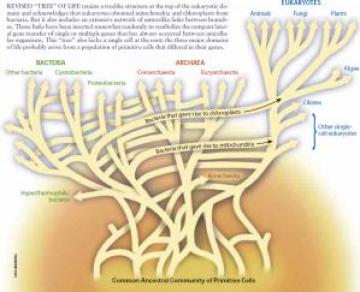Explore Evolution claims that certain scientists dispute the existence of a single universal ancestor, citing authors would not actually dispute universal common descent. They just disagree about the form it took, and the nature of the population of organisms from which modern living things evolved.
 An Uprooted Tree of Life: From W. Ford Doolittle (2000) "Uprooting the tree of life." Scientific American, 282(2):90-5. Note that distances are not necessarily to scale in this image. This image reflects a view held by some practicing scientists (including Dr. Doolittle, the author of the original article) that there was a period in life's early history when genes swapped so frequently that it is impossible to treat those earlier lineages as truly distinct, nor to trace those lineages back cleanly to a single ancestor. They do not dispute that life has some common ancestor, but they do seek to clarify how we talk about that ancestor.
An Uprooted Tree of Life: From W. Ford Doolittle (2000) "Uprooting the tree of life." Scientific American, 282(2):90-5. Note that distances are not necessarily to scale in this image. This image reflects a view held by some practicing scientists (including Dr. Doolittle, the author of the original article) that there was a period in life's early history when genes swapped so frequently that it is impossible to treat those earlier lineages as truly distinct, nor to trace those lineages back cleanly to a single ancestor. They do not dispute that life has some common ancestor, but they do seek to clarify how we talk about that ancestor. As discussed in the critique of the Introduction, there is ongoing research into the nature of the Last Universal Common Ancestor. Scientists traditionally envisioned an ancestral population of a single species which branched and gave rise to the modern diversity of life. More recently, researchers are suggesting that that ancestral population of bacteria was not composed of a single species, but of multiple species which swapped genes freely.
This is the point Michael Syvanen is making when he is quoted by Explore Evolution
Do the puzzles of conflicting phylogenetic trees or ORFans undermine the theory of Universal Common Descent? Most evolutionary biologists say no. Others are not so sure. Molecular evolutionist Michael Syvanen of the University of California-Davis argues that, "there is no reason to postulate that a LUCA (Last Universal Common Ancestor) ever existed."Explore Evolution, p. 61
Once again, Explore Evolution misrepresents the views of a scientist by selecting a phrase that sounds as though evolution were on shaky ground. This 'mined' quote suggests, incorrectly, that Syvanen is arguing against Universal Common Descent. Here is what Syvanen actually wrote, in a paper indicating that genes for certain biochemical pathways had been transferred between lineages long after their divergence:
There has been recent discussion that horizontal gene transfer is so frequent that it may never be possible to reconstruct the last common ancestor. However, if biochemical unities could be achieved after speciation events by horizontal gene transfer, then there is no reason to even postulate that a LUCA ever existed. If horizontal gene transfer is as common as I am implying, the modern cell could have evolved in multiple parallel lineages. Earliest life could have been truly polyphyletic.Michael Syvanen (2002) "On the occurrence of horizontal gene transfer among an arbitrarily chosen group of 26 genes," Journal of Molecular Evolution, 54:258-266
Syvanen is not necessarily disputing Universal Common Descent; he is disputing the existence of a Last Universal Cellular Ancestor [LUCA]. Syvanen is participating in an ongoing debate about the shape of the trunk of the tree of life. As shown in the figure above, some scientists see the evidence of extensive gene flow between ancient bacterial species as a sign that, at the base of the tree of life, lines between lineages were less clear, and that the branches didn't begin separating until a later point. Syvanen explained his views in some more depth in a post at the Panda's Thumb blog, pointing out that our increasingly detailed knowledge of the order in which certain ubiquitous genes evolved places greater and greater constraints on the composition of LUCA, and that "if we accept the existence of this LUCA there are a variety of reasons to believe that the LUCA itself was the product of an evolutionary process that employed horizontal transfer events." The full details of this debate require students to have a grasp of biological details that they will not have until after their high school biology classes, but an inquiry-based textbook might work with students to explain what sorts of research is under way to resolve some of these unresolved issues. Instead, Explore Evolution claims the existence of the discussion as proof that nothing is known, a profoundly unscientific attitude, and an unacceptable approach for a textbook to adopt. The existence of horizontal gene transfer, a major topic in discussions of the early tree of life, is not mentioned in the book's index, glossary, or relevant sections.
